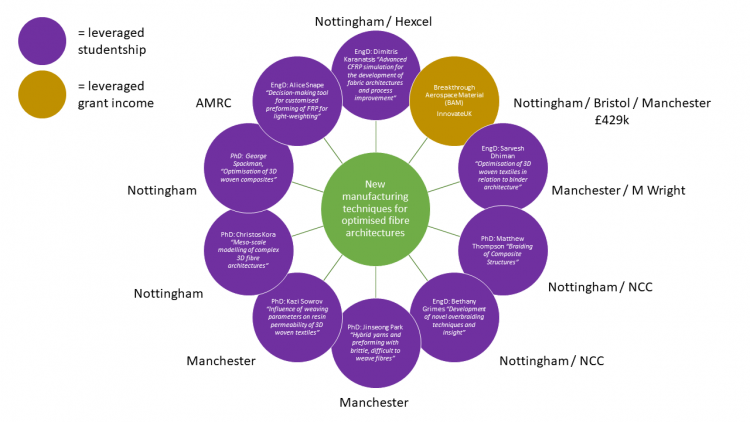
Work stream 2: New Manufacturing Techniques For Optimised Fibre Architectures
Host Institutions: The University of Manchester, The University of Nottingham
Start Date: 1st February, 2017
Duration: 64 months
Lead Investigators: Andrew Long, Prasad Potluri
Co-Investigators: Mikhail Matveev, Shankhachur Roy, Vivek Koncherry
Aims
This project aims to discover new 3D textile preform architectures, using computational modelling or “virtual testing” to evaluate the utility of different textile designs within an optimisation framework. This framework will not be constrained to architectures that can be produced using existing manufacturing technologies, such as weaving or braiding.
Optimum textile preforms will be realised either by modifying existing textile processes or, where potential benefits justify, by developing entirely new, bespoke manufacturing technologies. This will result in a step change in performance, leading to significant weight reductions and lower cycle times through routine use of automated manufacturing technologies. A CIMComp feasibility study previously demonstrated that, for a specific
application, a weight saving of at least 50% can be achieved by relaxing constraints on binder path and in-plane fibre orientations. Here we will further relax constraints on the fibre architecture, aiming to identify and manufacture a number of classes of improved material forms.
The project aims to discover new forms of 3D fibre reinforcements, enabling composites with higher specific properties to be manufactured compared to conventional 3D reinforcements. These new reinforcements will complement and extend the currently available class of 3D textiles, such as orthogonal weaves or layer-to-layer weaves. A computational framework will evaluate properties of various composites designs, and together with an optimisation algorithm, will select the best solution. The computational framework will implement a building-block approach where new models can be added at any stage to evaluate more reinforcements and resulting composites. Optimisation algorithms used within the framework will enable prediction of the best possible solution or a range of optimal solutions (a Pareto front). A series of case studies, developed through collaboration with industrial partners, will be used to demonstrate potential weight-savings or performance improvements by preform optimisation.

Key Achievements
- Computational framework for multi-objective optimisation of fibre reinforcements has been developed.
- The computational framework has been applied to an automotive demonstrator component.
- A novel meshing technique has been developed, which will be published as part of the Texgen open-source code.
- A novel multiaxial preforming concept has been demonstrated, which will be realised by developing new textile machinery based on these concepts.
- A novel preforming technique has been developed to manufacture flat and tubular multi-axial 3D fibre preforms.
Evidence of Impact
Webinar Presentations
‘Hub Overview’ Professor Nick Warrior, University of Nottingham
‘New Manufacturing Techniques for Optimised Fibre Architectures’ Professor Andy Long, University of Nottingham
‘Development of New Manufacturing Techniques for Complex Preforms’ Professor Prasad Potluri, University of Manchester
‘Numerical Framework for Optimisation of Fibre Preforms’ Dr Mikhail Matveev, University of Nottingham
‘Optimisation of 3D Woven T-joints’ George Spackman, University of Nottingham
‘Manufacturing of Optimised Preforms: Case Studies’ Dr Vivek Koncherry / Dr Shankhachur Roy, University of Manchester